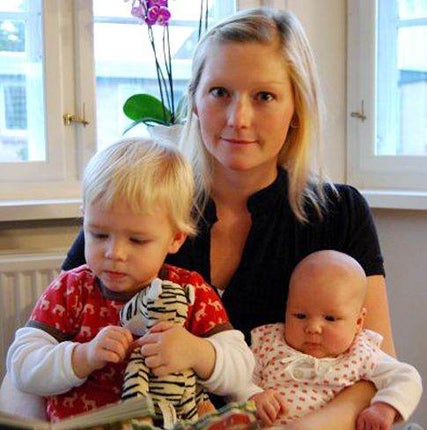Second baby after ovary transplant is a world first
Joy for woman after undergoing cancer treatment that usually destroys fertility

The proud mother shows off her children – as well she might. Stinne Holm Bergholdt, 32, never expected to have one baby, let alone two. "It is a miracle," she said yesterday.
She is the first woman in the world to have healthy babies in separate pregnancies after an ovarian transplant, following treatment for cancer which would otherwise have destroyed her fertility. According to her doctor, she could remain capable of producing babies into her seventies.
Nine children, including Mrs Bergholdt's two, have been born worldwide to women following the transplant of their own ovarian tissue that was frozen and later thawed. The success of Mrs Bergoldt's treatment increases the prospects of a family for the more than 18,000 women under the age of 44 who are diagnosed with cancer in Britain each year, three quarters of whom will be left infertile by treatment.
It will also revive speculation about the possibility that doctors may be able to reverse the menopause and allow women to extend their fertility into their sixties and beyond. Mrs Bergholdt, from Odense, Denmark, still has part of her ovary stored in liquid nitrogen available for transplant when she needs it. Professor Claus Andersen, her doctor, said it could be good for 40 years.
Diagnosed with a rare bone cancer when she was 27, Mrs Bergholdt was prescribed chemotherapy that would normally have destroyed her fertility. But before she began the cancer treatment in 2004, doctors removed part of her right ovary and froze it.
With the chemotherapy successfully completed, in December 2005 six thin strips of ovarian tissue were transplanted back on to what remained of her right ovary, which began to function again. She was given drugs to stimulate it and, with the help of IVF, she gave birth to her first daughter, Aviaja, in February 2007.
A year later she returned to the fertility clinic for a second attempt. However, a test revealed she was already pregnant having conceived naturally, and she gave birth to a healthy girl, Lucca, in September 2008. She said: "When I found out I was pregnant for the first time I was very happy and excited – but also very afraid and sceptical since I found it very hard to believe that my body was really working again. But eventually I started to believe that the pregnancy was really happening and began to enjoy every aspect of it.
"The second time it was a surprise to find out I was pregnant since we hadn't been working on it – we thought we'd need assistance like the first time. We had an appointment at the fertility outpatient clinic to talk about the possibility of a second baby, but it turned out that I was already pregnant, naturally. It was a very nice surprise to find out that my body was now functioning normally. It was indeed a miracle."
Andersen, who is professor of Human Reproductive Physiology at the University Hospital of Copenhagen, said: "This is the first time in the world that a woman has had two children from separate pregnancies as a result of transplanting frozen/thawed ovarian tissue. These results support cryopreservation of ovarian tissue as a valid method of fertility preservation and should encourage the development of this technique as a clinical procedure for girls and young women facing treatment that could damage their ovaries."
He added that the birth of Mrs Bergholdt's second child showed the transplanted ovarian strips had continued to work for more than four years. "It is an amazing fact that these ovarian strips have been working for so long and it provides information on how powerful this technique can be. She continues to have natural menstrual cycles and, at present, is using pregnancy-preventing measures to avoid becoming pregnant again."
Mrs Bergholdt, whose case is reported in the journal Human Reproduction, has seven more strips of tissue still frozen in liquid nitrogen and can return to have them transplanted if the existing strips stop working, Professor Andersen said. "As long as the tissue remains properly stored in liquid nitrogen, it could remain functional for as long as 40 years. However, we do not know this for certain at present."
For the present, Mrs Bergholdt is enjoying her two daughters and putting off thoughts about extending the family. "The girls are still so small and need a lot of attention, but maybe in a couple of years we might think about it again."
Subscribe to Independent Premium to bookmark this article
Want to bookmark your favourite articles and stories to read or reference later? Start your Independent Premium subscription today.

Join our commenting forum
Join thought-provoking conversations, follow other Independent readers and see their replies